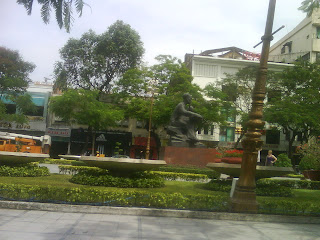It was the afternoon before the eve of Chinese New Year and I had barely recovered from my overseas trip two days before. The drab sky had turned dark, with pale sunlight seeping through in patches of light blue. We arrived at the Pusat Penjagaan Kanak-Kanak Cacat Taman Megah (PPKKCTM) just as the rain pelted on the windscreen.
We were there simply because it is family tradition to visit a home before Chinese New Year.
Below: Baskar, manager of PPKKCTM
The people
According to Baskar the manager of the home, PPKKCTM is housed with 132 people, mostly children, mostly physically and mentally challenged. The majority of the children are abandoned by their parents upon birth.
There were about 10-15 visitors; physio-therapy for the children was in full swing. Baskar was a busy guy and we were in the main area where the clinic, kindergarten, physio-therapy and other activities were carried out. I flicked out my C902 and asked for permission to snap photographs.
"Now, why would anyone abandoned their children?", I quizzed Baskar.
"Well, not all are abandoned by their parents, but mostly are. Most of the children here- besides being handicapped, are in multiple situations- broken home, odd-job parents and so on." My eyes gazed outside the house, the busy courtyard, where the rest of children were.
Below: 'Their parents just can't face the pain...'
Baskar continued, "Some parents continue to visit their children after sending them here, but many loose strength and stop coming altogether as time goes by. They just can't face the pain. Some (parents) also tell us not to bother them even if their kid passes away."
He pointed to Patrick, a four-year old left in a box by his parents under the scorching afternoon sun at the longkang outside the PPKKCTM premises. Under the care of the centre Patrick underwent brain surgery to remove fluids from this head. As as result of this surgery he lost most of his sight. During our visit he was strapped to contraption, undergoing occupational therapy. According to Baskar, Patrick is also suffering from cerebal palsy and muscular dystrophy.
Below: Patrick, 4, abandoned by parents under
the scorching sun about a year ago. He is not
Above: Sri, 3 months old, suffering from multple conditions.
She breaths through a tube because there is no other way to do so.
The home
The PPKKCTM has been given a year from December 2008 to move out of its premises at Taman Megah- because of neighbours and the authorities. Firstly, the residents there do not welcome the added noise and activities going on; secondly, there's no permit to convert that part of the area from residential house to care centre. The PPKKCTM has acquired a parcel of land which they need RM4.1 million more to develop the centre before they can move in. According to Cheah Siong Nyin, PPKKCTM 's Trustee, they are running of time. They have sought MP Tony Phua's assistance but was adivsed to raise funds quickly.
The chidlren are from all races, out of the 132, only about 100 are disabled- the rest are normal children.
Home-activities
Quran classes, speech therapy (whistle blowing, straw-sucking, tongue folding, etc), special studies, physio and occupational therapy (walking, standing, sitting, etc).
The expenses
The centre has a burn-rate of RM60K per month. This cost does not include capital expenditure for special therapy equipment. Most of it go to medical care, food and staff wages. The source of income remains mainly from donations- it has stopped selling souvenirs (which it previously does) because of of the lack of a license.
I doubt I can describe the hardship here in its true sense. Go visit this place to feel this place yourself.
Charity begins at home- before we look to help others abroad, let's fix up our backyard first. God Bless, and have a Happy Chinese New Year.
Donations can be addressed to: "Pusat Penjagaan Kanak-kanak Cacat Taman Megah"
Bank Account: RHB Bank BHD TMN Megah Branch Account No: 26220500000121
Tax exempt ref: LHDN.01/35/42.51/179-6.4935































